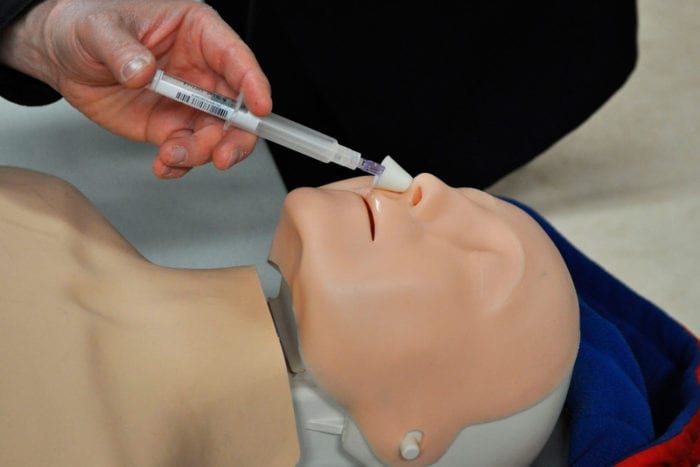By Jill Webb
For five years the Suffolk County Department of Health’s Opioid Overdose Prevention Project has been doing their part to help community members save lives. To commemorate the project’s fifth anniversary an Opioid Overdose Prevention class was held July 31 at the William J. Lindsay County Complex in Hauppauge.
The class trained participants in the essential steps to handling an opioid overdose: recognizing the overdose, administering intranasal Narcan, and what to do while the Emergency Medical Service teams are en-route. These training procedures meet the New York State Department of Health requirements, and at completion of the course, students received a certificate along with an emergency resuscitation kit, which contains the Narcan Nasal Spray.
Narcan, also known as Naloxone, is administered to reverse an opioid overdose, and has saved many lives. Before the project was put into place, only advanced Emergency Medical Services providers could administer Narcan to overdose victims.
“The No. 1 incentive is to receive a free Narcan kit,” Dr. Gregson Pigott, EMS medical director and clinical director of the Opioid Overdose Prevention Program, said. “That’s really the draw.”
He said the class appeals to many people in the field, such as nurses or treatment professionals.
AnnMarie Csorny, director of the department of health’s community mental hygiene services, said another motivation to take the class is “to be better informed, and to have a kit available on you that you would be able to use should you see someone. It doesn’t always have to be your loved one, it could be someone in the community.”
Starting in 2012, the department of health services’ division of emergency medical services has held more than 278 classes. Within this time, approximately 9,000 participants have learned how to recognize an opioid overdose and administer Narcan. Since its start, Narcan has saved the lives of over 3,000 individuals.
Those who have been trained in administering Narcan include EMTs, school district staff and opioid users themselves. The program has developed from how to handle an overdose into adding a discussion of opioid addiction.
“Initially it was just about recognizing signs and symptoms of overdose, how Naloxone is packaged, what it does, what it doesn’t do, what to expect when you administer it, and how to get a refill,” Pigott said.
Now, the program integrates treatment aspects along with prevention techniques.
“I don’t wanna say we just give them Narcan and say, ‘OK here’s how to give it out.’ Pigott said. “I’d like to give them a little bit more background on the epidemic and how we got to where we are, and resources. You have a lot of parents in there who are anxious that they have a son or daughter who is hooked on this stuff. They don’t just want Narcan, they want help for their son or daughter.”
Taking it a step further, in 2016 the county health department started to work with local hospitals to get Narcan kits to those who are at risk of an opioid overdose. They also help educate them along with their families on the risk factors, signs, and symptoms of an opioid overdose.
Suffolk County also operates, with the help of the Long Island Council on Alcoholism and Drug Dependence, a 24/7 substance abuse hotline at 631-979-1700. The line was established in April 2016 for crises, and has received 1,217 calls as of May 31.
On the Opioid Overdose Prevention Program’s impact, Csorny believes it’s a start to tackling a huge issue.
“I think it’s certainly opened the discussion of lines of communication,” Csorny said. “It has, I believe, empowered people to get the support they need and to talk about the things that are not there.”
While the program has educated hundreds of people, and saves many lives, Pigott knows more needs to be done in handling the opioid epidemic.
“I’m realizing that Narcan isn’t the answer,” Pigott said. “It’s a nice thing to say, ‘Hey I got a save, this person was turning blue, not breathing, and then I squirted the stuff up the nose and we got them back.’ But then on the backside of that, the person wakes up and they’re like, ‘Ugh, what just happened to me?’ and then all of a sudden withdrawal kicks in.”
Pigott said after the withdrawal kicks in the users will decide to get treatment or not to, and if they chose the latter they will most likely start using again — administrating Narcan isn’t going to change that.
“That’s the biggest problem we have: it’s a quick fix, and you’re really not fixing anything,” Pigott said. “It’s much more complicated than just giving out Narcan.”
The next step in handling the opioid epidemic, according to Pigott, is getting better treatment options. He said most of the county’s treatment programs are abstinence-based; detox programs in learning how to be drug-free.
“It might be effective at the time but once you’re out of the program it’s easy to get tempted, easy to relapse,” Pigott said. “I think treatment needs to be addressed more and I think there needs to be more options for people.”





